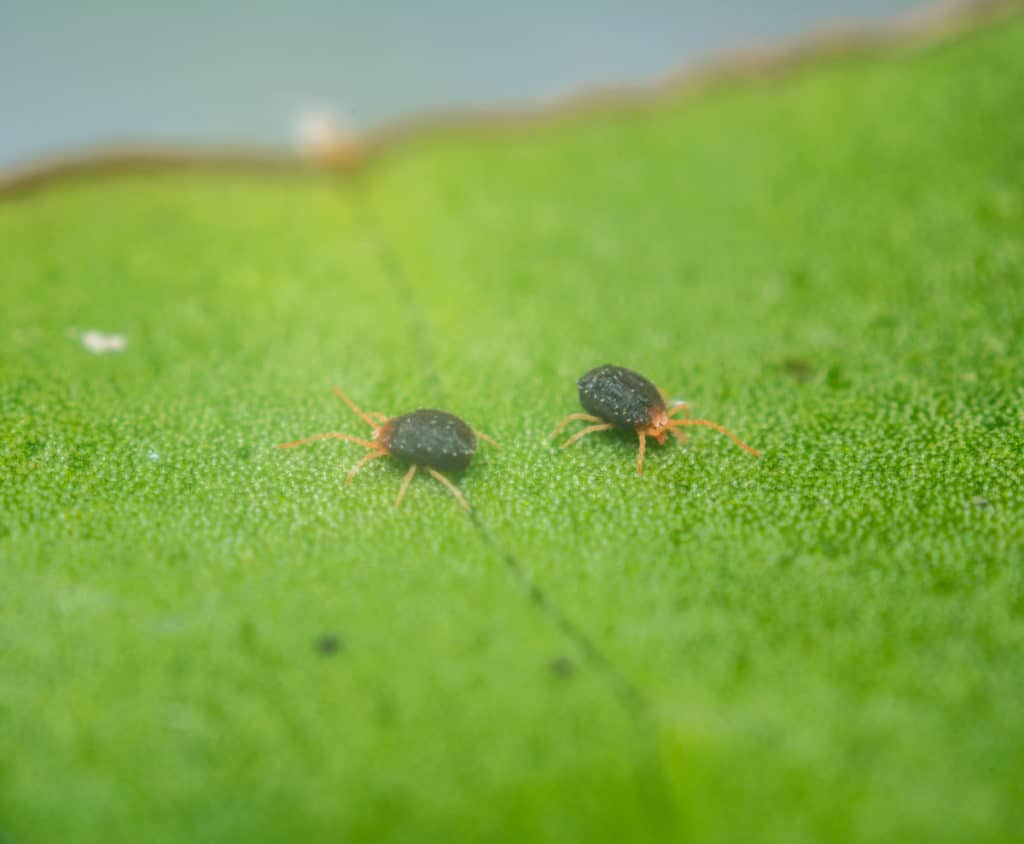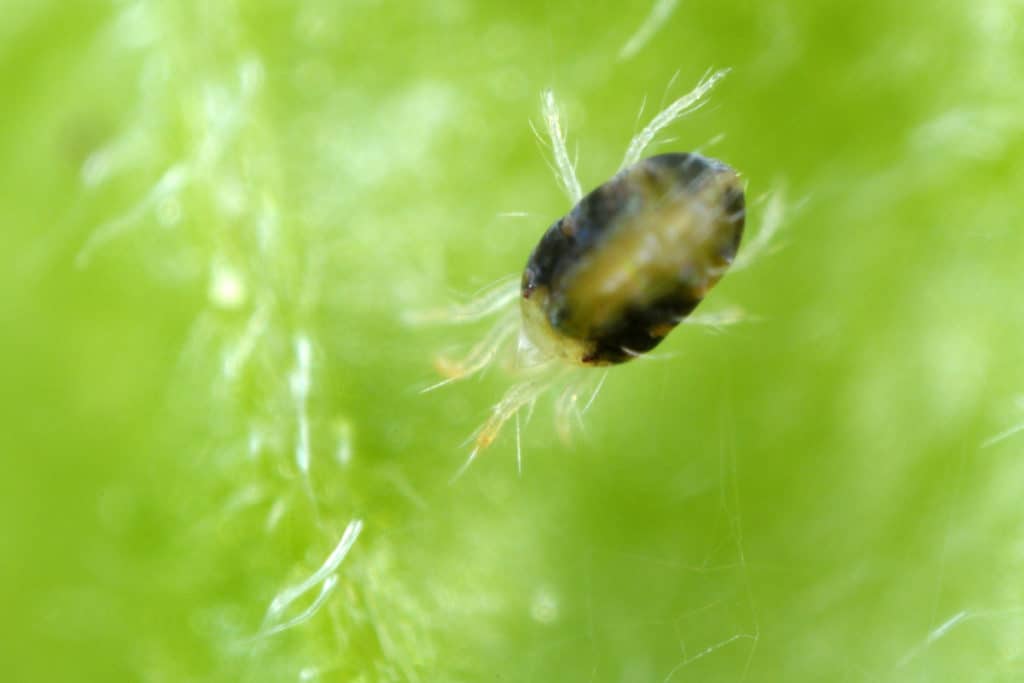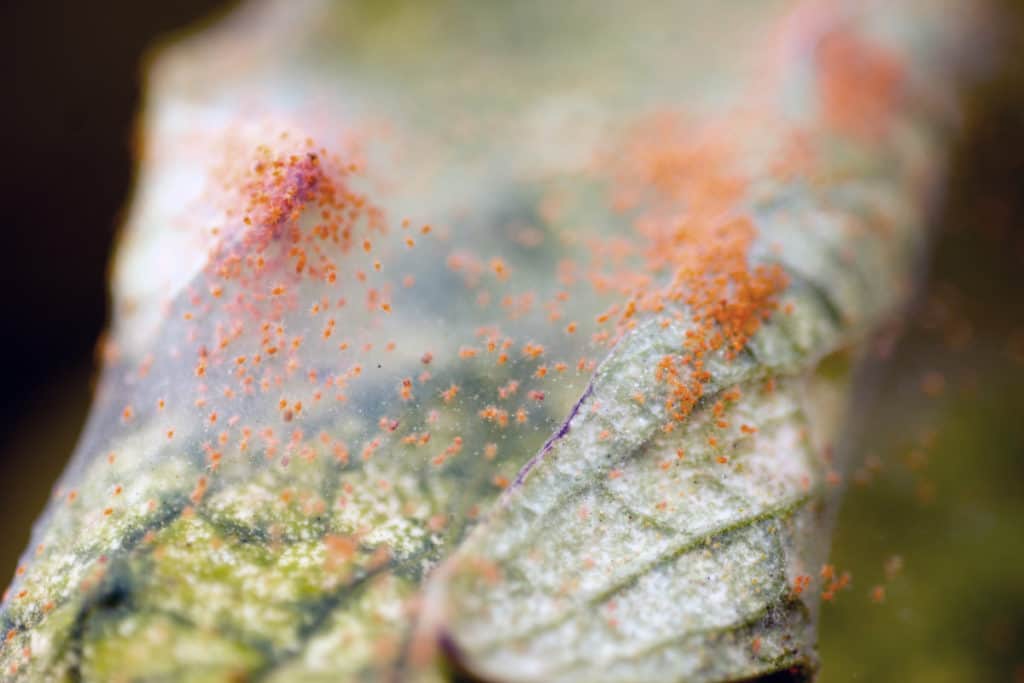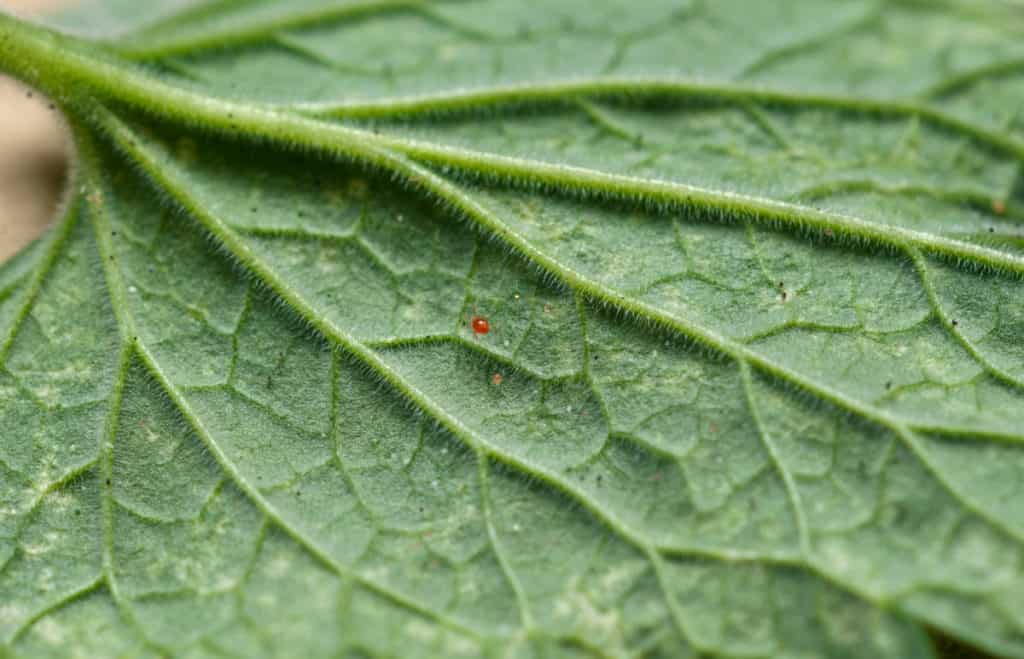Over 48,000 identified species of mites in the world belong to the Acariforme, opliocariforme, or parasitiforme groups. Even though clover mites and spider mites are both acariformes, they belong to different subfamilies.
In this article we are going to take a closer look at what the difference is between Clover Mites and Spider Mites. Also, we are going to give you some tips on how to control these pests if you find them in your garden.
Appearance
Clover Mites
The clover mite is reddish-brown to bright red in color, but in some cases, there are some that have an olive-green hue. It typically measures about 1/30 of an inch. They are oval with eight legs, but the front legs are longer than the other three pairs. These front legs look more like antennae than legs, but they are instrumental in helping the mite move fast.

Like most of the other mites, Clover mites have a distinct head attached to the thorax section and the abdomen sections as well. It is possible to observe clover mites with your naked eye.
Spider Mites
The two-dotted spider mite has a yellow-orange hue and two distinct dots on each side of the body. They measure about 1/50th of an inch, making them smaller than clover mites. You would need a microscope to see these mites.

Unlike clover mites, spider mites have two distinct body parts: gnathosoma and idiosoma. The gnathosoma section only has the mouthparts while the idiosoma features the head, thorax, and abdomen together.
The spruce spider mite is green in color, while the southern spider mite is red in color. All spider mites have eight eggs.
If you think you might have some clover mites in your yard then it would be worth checking out this article we have written to make sure they aren’t actually chiggers, Clover Mites Vs Chiggers – Are They The Same Thing?
What Time Of Year Do They Appear
Clover Mites
Clover mites are considered to be cool-season mites as they appear during fall and spring. These tiny critters favor the south-facing sides of the house, which are warm during these seasons.
Their eggs hatch in fall and spring because this time of year has temperatures of between 70 and 85 degrees Fahrenheit, which are conducive for their larvae to thrive and grow. As they hatch, the population of the mites explodes and you can see them crawling on your lawn and concrete paths.
Spider Mites
The spider mite is a warm-season mite occurring in the hot drought-like months of summer. Species of spider mites like the two dotted spider mites are most active in June until September. During the cooler months, they slow down their activity levels and go into hibernation-overwinter in the host plant’s mulch and soil.
But some species such as the spruce and southern spider mites favor the cooler seasons that come out from summer hibernation in autumn and continue to feed and reproduce during the spring and fall months.
Life Cycle
Clover Mites
Clover mites reproduce by parthenogenesis, meaning they lay viable eggs that do not need to be fertilized by a male. These mites only exist in female form. The females lay up to 70 eggs, with each egg maturing in 30 days.
They lay their eggs outdoors under tree barks, crack and crevices in the foundation walls, and on cracked fence posts. Once the temperatures reach 85 degrees Fahrenheit, they stop laying eggs, and the already laid eggs lay dormant until fall when they hatch. The eggs are reddish-brown in color.
The eggs go through four life cycles: egg, larva, nymph, and adult. The adult clover mite lives for only two weeks.
If you are wondering if clover mites have the ability to fly then check out this article we have written, Do Clover Mites Fly?
Spider Mites
The male spider mite approaches a female when the latter is still in its final larval stage and helps it shed its exoskeleton before mating with the female as it emerges into adulthood. The female is usually immobile at the time of mating. This timing is crucial for these mites because only the sperm from the first mating fertilizes the eggs.
When the male approaches the immobile female, they know she is ready for mating if she eventually starts to move.
The female is capable of laying hundreds of eggs during its two to four-week lifespan. The eggs are attached to a silk web, and they hatch in three days. These mites tend to complete their cycle from egg to adult in five to twenty days, depending on the temperatures. Optimum temperatures for faster egg hatching are approximately 80 degrees Fahrenheit.
A typical life cycle of a spider mite entails an egg hatching into a larva. But they have two nymphal stages: protonymph and deutonymph. After the two nymphal stages, the adult finally emerges.
Locations
Clover Mites
Clover mites are found outdoors for most of the time, but they go indoors into cracks and crevices to hibernate during the colder months of the year. When they first come out in the fall and spring months, they congregate on top of vegetation and on the building’s sun-facing sides. That is why your lawn may appear bronze because they rest on the surface of leaves and grass blades.
Clover mites can be found on all continents except for Antarctica. These mites hibernate in crevices and cracks.
Spider Mites
Spider mites are slightly harder to detect because they tend to hide on the underside of leaves. But they are also outdoor mites where they spin a silky web under the leaf to protect themselves and anchor their eggs to the plant.

Spider mites hibernate in the soil underneath their host plant, which makes it hard for them to be affected by pesticide application on the surface of the plant. The mites are widely distributed worldwide and can move easily from one place to another using the wind.
Diet
Clover Mites
These are herbivorous mites subsisting on a diet of plants only. They are particularly fond of clover hence the name clover mites. They suck the juicy sap of the plant’s leaves, leaving small white spots.
Clover mites are particularly attracted to heavily fertilized lawns because the plants on such lawns are thriving and offer a sustainable food source. Once the lawn is established and fertilized less, the populations noticeably decreased.
Apart from clover, these mites also feed on grass and other plants commonly found on a lawn. They also feed on mold and mildew, so it is not surprising to find them on rooftops and patios, and other areas with mold.
For more about the diets of clover mites check out this article we have written, What Do Clover Mites Eat?
Spider Mites
Spider mites eat vegetation, but they eat most of the plants that are beneficial to human beings. They favor crops grown in glasshouses like cucumbers, tomatoes, strawberries, peppers, and flowers like orchids, chrysanthemums, and ornamental plants.
They also affect field crops like cotton, legumes, soybeans, grapevines, apples, and pears. In pacific island countries, these mites are a problem that occurs on plants like okra, papaya, and cassava. Worldwide, spider mites love to invade food crops.
Spider mites feed on the chlorophyll on the leaves, and they completely empty the plant of chlorophyll, leaving it to die. They leave yellow spots all over the leaf.
For more about the diets of spider mites check out this article we have written, What Do Spider Mites Eat?
Are They Harmful To Humans And Pets?
Clover Mites
Clover mites are not dangerous to human beings because they are herbivorous. They feed on plants found mostly in your garden. And even when they enter your space, they are looking for a place to hide.
Unfortunately, when squashed, they leave behind a red stain that is difficult to get rid of.
If you are interested we have a whole article on the potential dangers of clover mites. The article is called, Are Clover Mites Harmful?
Spider Mites
They are also herbivorous, but they can become a risk factor in food security for human beings. That is because of the types of plants they invade. Spider mites favor food crops all around the world, and in large numbers, they can destroy an entire crop.
Unfortunately, because they multiply very quickly, they can destroy crops within a short period.
Taxonomy
Clover Mite Taxonomy
The clover mites belong to the Acari subclass of the animal kingdom. Its species is Bryobia praetiosa.
Here is their complete taxonomy
Phylum: Arthropoda
Class: Arachnida
Order: Trombidiformes
Family: Tetranychidae
Genus: Bryobia
Spider Mite Taxonomy
The spider mite is also from the Acari subclass and the animal kingdom.
Below is the taxonomy:
Phylum: Arthropoda
Subphylum: Chelicerata
Class: Arachnida
Order: Trombidiformes
Superfamily: Tetranychoidea
Family: Tetranychidae
Spider mites have two subfamilies: Bryobinae and Tetranychinae.
Overview Of The Differences Between Clover Mites And Spider Mites
Clover Mites | Spider Mites |
Clover mites reproduce by parthenogenesis | The males and females mate for reproduction |
They have one nymphal stage | They have two nymphal stages |
They have elongated front legs | All their legs are the same size |
They eat grass and weeds | They eat food crops |
They are cool-season mites | They are warm-season mites |
What Is Similar Between Clover And Spider Mites?
Both are either red or green in color, which can cause you to mistake one for the other. They are also small in size. Both mites leave a stippling effect on the plants they infest. Stippling is the feeding damage that results in a spotted appearance on the leaves of the affected plant.
Leaf stippling interferes with photosynthesis because it is robbed of its chlorophyll, which helps make the plant’s food. Clover and spider mites also both have eight legs, and they are outdoor mites.
While both these mites are not harmful to human beings, they are terrible for plant life. That means they pose a risk to food security when they invade.
How To Get Rid Of Clover Mites?
Clover mites can be removed by using insecticides. But make sure that the professionals apply the insecticides for the following reasons
- If the mites are within the foundation, the professionals have the right equipment to reach them.
- Some of the chemicals can change the soil composition of your lawn
- The pest control experts will have a long-term plan on how to tackle a full-on infestation
- They will give you the right advice on what to do to avoid another infestation
But if you would like a home remedy for clover mites, there is the option of using baking powder as a natural barrier. Sprinkle some baking powder along the borders of your garden to keep the mites restricted within the garden. When they are restricted in one place, it is easier to kill.
Diatomaceous earth is also effective in repelling mite populations. And because it is not harmful to human beings and your pets, you can sprinkle it liberally on your lawn and the backyard. You can also use it around your foundation’s perimeter to deter the clover mites from climbing up the building. However, you must ensure the diatomaceous earth you use is food grade.
Also, just a wipe down with a cloth or sponge dipped in vinegar effectively removes and repels these mites in the house. Add the vinegar to some water and spray the window sills, under the doors, and other entry points into the house to repel the insects.
When it comes to getting rid of clover mites on concrete, the first line of defense is water. Washing them in a strong stream of water can get rid of much of the population. Direct the nozzle into the cracks and crevices in the concrete to dislodge the mites’ eggs.
How To Get Rid Of Spider Mites
First, make sure that you correctly identify the presence of spider mites. That could be by checking ornamental plants for cobwebs and also the underside of leaves for any signs of stippling. A spider mite leaves its delicate trademark webbing on the plants it is feeding on as the leaves turn yellow gradually.
Once you have correctly identified the spider mites, here are something you can try:
- Hose down the plants using sprinkles or using a hose. Make sure the jet of water is sufficient to dislodge them and drown them. A strong jet ensures that you also use just enough water, avoiding overwatering the soil and affecting plant growth.
- Next, apply neem oil mixed with water. Neem oil is a natural pesticide, and the water helps spread it onto all the plants. Also, neem is excellent because it is not toxic, so it won’t harm birds, pollinators, and other insects around the plants. You can apply the neem pesticide after every seven-day intervals.
- If the infestation is high, consider using insecticidal soap, which is a stronger treatment. Apply in the evenings to all the plants with 10-day intervals in between. Make sure that the plant is away from direct sunlight as the combination of sun and insecticide chemicals can cause the leaves to burn.
- Continually monitor the plants and once the infestation is over, keep wiping the leaves or sprinkling water on them to keep the mites off. Spider mites like dry spots, so the presence of water deters them.
This is an effective home remedy.
But if you prefer to use professional services for a large piece of land, make sure that no broad-spectrum insecticide is used. Such insecticide also kills off beneficial insects that eat the mites like thrips, ladybugs, and pirate bugs. Killing off these beneficial insects can result in an unchecked mite population explosion if the insecticide doesn’t work.

A professional who is aware of taking care of such elements will use organic acaricides. These can make contact with mites even hidden inside the soil, like hibernating spider mites. They prefer this option because organic acaricides do not make the harvested crop dangerous to consume like some chemical insecticides.
We have written a whole article on what eats spider mites if you are interested. The article is called, What Eats Spider Mites?
The Wrap Up
If you have moderate populations of both spider mites and clover mites, you can consider the home remedies outlined above to remove them from your garden and house, respectively.
Spider mites are more harmful to the environment compared to clover mites, even though they are both pests that cause stippling to the foliage of plants.
But as far as harming you or your pet, they have no direct interactions with humans or animals that can result in disease.
Most mite populations can also be controlled by introducing predatory mites like Persimilis that like to feed on two-spotted spider mites. You can also consider getting lady beetles and thrips, which love to feed on soft-bodied insects like mites.
It is possible to have your plants at their healthiest without having to resort to chemical pesticides to remove mites.
If you like this kind of comparison style article then you might be interested in some of these other articles we have written in this style:
Praying Mantis Vs Stick Bug. Are They The Same Thing?
Carpenter Bees Vs Bumblebees Vs Honey Bees
Wasp Nest Vs Bee Nest. How Different Are They, Really?
Sources
https://plant-pest-advisory.rutgers.edu/cool-season-mites-wax-as-the-warm-season-mites-wane/
https://www.nocopwcontrol.com/pest-control/clover-and-spider-mites/
https://entomology.ca.uky.edu/ef438
http://entnemdept.ufl.edu/creatures/orn/twospotted_mite.htm
https://web.extension.illinois.edu/focus/index.cfm?problem=spruce-spider-mite
https://greeneryunlimited.co/blogs/plant-care/how-to-treat-spider-mites-on-indoor-houseplants
https://www.sciencedirect.com/topics/agricultural-and-biological-sciences/parthenogenesis
http://entnemdept.ufl.edu/creatures/orn/mites/clover_mite.htm
http://entnemdept.ufl.edu/creatures/orn/shrubs/southern_red_mite.htm
